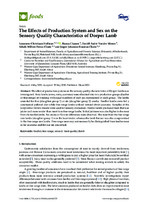| dc.contributor.author | Petrus Cloete, Schalk Willem | |
| dc.contributor.author | Claasen, Bianca | |
| dc.contributor.author | van der Merwe, Daniël André | |
| dc.date.accessioned | 2020-11-23T09:33:45Z | |
| dc.date.available | 2020-11-23T09:33:45Z | |
| dc.date.issued | 2020 | |
| dc.identifier.citation | Petrus Cloete, S. W. et al. (2020). The effects of production system and sex on the sensory quality characteristics of dorperb lamb. Foods, 9(6),725 | en_US |
| dc.identifier.issn | 2304-8158 | |
| dc.identifier.uri | https://doi.org/10.3390/foods9060725 | |
| dc.identifier.uri | http://hdl.handle.net/10566/5457 | |
| dc.description.abstract | The effect of production systems on the sensory quality characteristics of Dorper lambs was
investigated. Sixty lambs (ewes, rams, castrates) were allocated into two production groups (feedlot
or free-range) at weaning with equal numbers of each sex represented in each group. The lambs
were fed for five (slaughter group 1) or six (slaughter group 2) weeks. Feedlot lambs were fed a
commercial pelleted diet while free-range lambs utilized natural shrub pastures. Samples of the
Longissimus thoracis muscle were used for sensory evaluation. Feedlot lambs produced meat that was
juicier and more tender than meat from free-range lambs. | en_US |
| dc.language.iso | en | en_US |
| dc.publisher | Multidisciplinary Digital Publishing Institute (MDPI) | en_US |
| dc.subject | Feedlot | en_US |
| dc.subject | Free-range | en_US |
| dc.subject | Sensory meat quality | en_US |
| dc.subject | Lamb | en_US |
| dc.title | The effects of production system and sex on the sensory quality characteristics of dorperb lamb | en_US |
| dc.type | Article | en_US |

